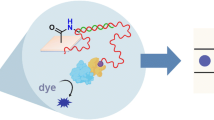Abstract
Hereditary hemochromatosis is an autosomal recessive disease highly prevalent in Northern Europe. Here we describe the performance of a genetic test for two mutations of the HFE gene (C282Y and H63D). It is based on a solid-phase PCR coupled with an α-phosphorothioate-mediated primer extension, conferring resistance to hydrolysis by ExoIII. Next, Elisa-like detection allows a colorimetric reading of the genetic test. We performed 322 tests (212 on the C282Y mutation, 110 on the H63D mutation) and compared the results with the RFLP method. Using OD ranges giving the minimum of uncertainty, the tests lead to high specificity and sensitivity, and they address the detection of mutated or normal bases in the HFE gene or the deduced phenotype (safe or ill), with positive predictive values or negative ones greater than 0.96. This method is therefore proposed as a primary test or as a confirming test.

Similar content being viewed by others
References
Barany F (1991) Genetic disease detection and DNA amplification using cloned thermostable ligase. Proc Natl Acad Sci USA 88:189–193
Brugere JF, Gobron S, Baud E, Cailloux F (2008) Single-tube genotyping using a solid-phase method that combines alpha-phosphorothioate-mediated primer extension and ExoIII: proof of concept with the F508del cystic fibrosis diagnosis. Mol Cell Probes 22:320–323
European Association for the Study of the Liver (2010) EASL clinical practice guidelines for HFE hemochromatosis. J Hepatol 53:3–22
Feder JN, Gnirke A, Thomas W, Tsuchihashi Z, Ruddy DA et al (1996) A novel MHC class I-like gene is mutated in patients with hereditary haemochromatosis. Nat Genet 13:399–408
Jennings L, Van Deerlin VM, Gulley ML (2009) Recommended principles and practices for validating clinical molecular pathology tests. Arch Pathol Lab Med 133:743–755
Newton CR, Graham A, Heptinstall LE, Powell SJ, Summers C, Kalsheker N, Smith JC, Markham AF (1989) Analysis of any point mutation in DNA: the amplification refractory mutation system (ARMS). Nucleic Acids Res 17:2503–2516
Oroskar AA, Rasmussen SE, Rasmussen HN, Rasmussen SR, Sullivan BM, Johansson A (1996) Detection of immobilized amplicons by ELISA-like techniques. Clin Chem 42:1547–1555
Palsdottir A, Cross SJ, Edwards JH, Carroll MC (1983) Correlation between a DNA restriction fragment length polymorphism and C4A6 protein. Nature 306:615–616
Pietrangelo A (2010) Hereditary hemochromatosis: pathogenesis, diagnosis, and treatment. Gastroenterology 139(393–408):e1–e2
Putney SD, Benkovic SJ, Schimmel PR (1981) A DNA fragment with an alpha-phosphorothioate nucleotide at one end is asymmetrically blocked from digestion by exonuclease III and can be replicated in vivo. Proc Natl Acad Sci USA 78:7350–7354
Ramakrishna R, Gupta S, Sarathy K, Bowen A (2012) Phenotypic and clinical manifestations of compound heterozygous genetic haemochromatosis (CHGH): a noninvasive approach to clinical management. Intern Med J 43(3):254–261
Rasmussen SR, Larsen MR, Rasmussen SE (1991) Covalent immobilization of DNA onto polystyrene microwells: the molecules are only bound at the 5′ end. Anal Biochem 198:138–142
Rochette J, Le Gac G, Lassoued K, Ferec C, Robson KJ (2010) Factors influencing disease phenotype and penetrance in HFE haemochromatosis. Hum Genet 128:233–248
Santos PCJL, Krieger JE, Pereira AC (2012) Molecular diagnostic and pathogenesis of hereditary haemochromatosis. Int J Mol Sci 13:1497–1511
Syvanen AC (1999) From gels to chips: minisequencing primer extension for analysis of point mutations and single nucleotide polymorphisms. Hum Mutat 13:1–10
Yeung AT, Hattangadi D, Blakesley L, Nicolas E (2005) Enzymatic mutation detection technologies. Biotechniques 38:749–758
Acknowledgments
The authors thank Tina Kristiensen and Svend Rasmussen from the R&D Department at NUNC, Denmark. They are also grateful to Anne Pernin and Laurence Surrel from Nucleica S.A. for their technical assistance. They would like to thank Prof. I. Creveaux and Prof. B. Dastugue of the Laboratoire de Biochimie Médicale for their support and their help in validation of the test.
Author information
Authors and Affiliations
Corresponding author
Rights and permissions
About this article
Cite this article
Brugère, JF., Gobron, S., Baud, E. et al. Design and Validation of a Colorimetric Test for the Genetic Diagnosis of Hemochromatosis Using α-Phosphorothioate Nucleotides. Biochem Genet 51, 635–643 (2013). https://doi.org/10.1007/s10528-013-9593-x
Received:
Accepted:
Published:
Issue Date:
DOI: https://doi.org/10.1007/s10528-013-9593-x




